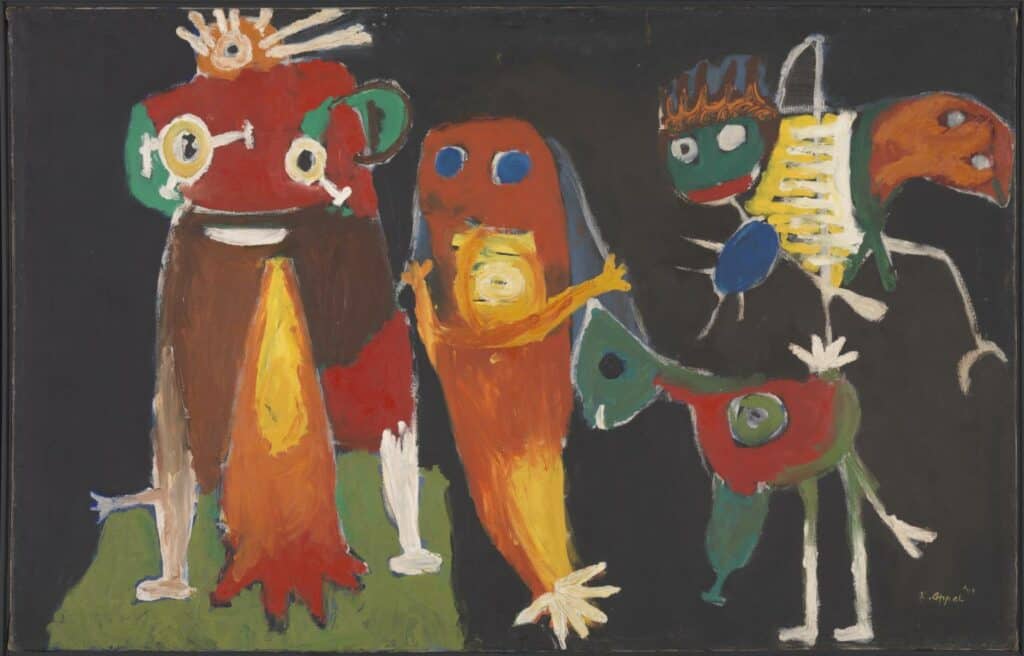Articles and Features
Art Movement: CoBrA
By Shira Wolfe
“We wanted to start again, like a child.”
Karel Appel
What was CoBrA?
CoBrA was an international art movement of pioneering artists who caused a revolution in modern art following World War II. It was the first truly international post-war avant-garde art movement, whose members sought new means of expression, based on spontaneity and experimentation, for a new society. Formed on 8 November 1948 in Paris by Karel Appel, Constant Nieuwenhuys, Corneille, Christian Dotrement, Asger Jorn and Joseph Noiret, CoBrA was chosen as the group’s name since it is an acronym for Copenhagen, Brussels and Amsterdam, the home cities of the collective’s founders. Though the group only lasted till November 1951, it had a lasting impact on art and in many ways continued to exist informally.
Key period: 1948-1951
Key regions: Copenhagen, Brussels, Amsterdam
Key words: Creation before theory, materialism, mark making, spontaneity, experimentation
Key artists: Constant Nieuwenhuijs, Karel Appel, Corneille, Asger Jorn, Christian Dotremont, Joseph Noiret

The Formation of CoBrA
In 1948, several Danish, Dutch and Belgian artists travelled to Paris to attend an international conference on Surrealism. The Belgian poet Christian Dotremont did not agree with the attitude of the Surrealists, whom he found far too theoretical. He believed that art must bring about real social change, and decided to set up a new artist collective promoting new experimental art. He found kindred spirits in the fellow Belgian artist Joseph Noiret, the Danish Asger Jorn, and Dutch artists Karel Appel, Constant Nieuwenhuijs and Corneille. They signed the founding CoBrA Manifesto on 8 November 1948 in the Hôtel Notre Dame café. It was the first post-war collaboration of European artists and more artists and writers joined the group after its formation.
The founding principles that united the artists were as follows: creation before theory; art must have roots; materialism which begins with the material; the mark as a sign of wellbeing, spontaneity, experimentation. Dotrement came up with the group’s moniker, which was derived from its members’ home cities Copenhagen, Brussels and Amsterdam.

“In this period of change, the role of the creative artist can only be that of the revolutionary: it is his duty to destroy the last remnants of an empty, irksome aesthetic, arousing the creative instincts still slumbering unconscious in the human mind.”
Constant Nieuwenhuys
The Evolution of Cobra
The CoBrA artists strove to achieve a direct and spontaneous type of expression. “In this period of change, the role of the creative artist can only be that of the revolutionary: it is his duty to destroy the last remnants of an empty, irksome aesthetic, arousing the creative instincts still slumbering unconscious in the human mind,” explained Constant Nieuwenhuys. The artists searched for inspiration in the creative expression of children and mentally handicapped people, naïve art, folk art, non-Western and tribal art, and also in Scandinavian primitive art from the Middle ages and prehistory. Experimentation with materials, working methods, and various forms of expression were all important aspects of their work. The artists were strongly opposed to nationalism and the dominant culture of the bourgeoisie. They worked together on collaborative word paintings, a magazine, books, prints, exhibitions, and murals.
The CoBrA artists felt that an image should appear on the canvas as naturally and quickly as the sudden changes in the weather, and that it should be impersonal. By this they meant that the idea of the artist as a genius individual should be done away with. “Anonymity is the great hygiene,” said Dotremont. Although the artists shared Marxist politics, none of them were interested in theorising. Instead, they believed that exemplary action would break down the barriers isolating people in their bourgeois complacency.
The CoBrA members favoured flat and childlike forms with rough outlines and thick paint. Looking at their artworks they are strikingly similar, truly conjuring up similar feelings and experiences, yet each artist brought his own flavour. Constant, for example, tended towards darkness, while Appel’s colours are brighter. In Jorn’s works, you can make out faint traces of traditional drawing amidst the otherwise crude and wild forms.

1949 Exhibition at Amsterdam Stedelijk Museum
In 1949 Willem Sandberg, the then director of the Stedelijk Museum in Amsterdam, decided to organise an exhibition of CoBrA art. He admired the energy of the CoBrA artists, but was worried it wouldn’t come across in full force due to the small canvases they usually worked with. The artists worked on a small scale since there was no interest in their work from the commercial art market, so they could not afford larger canvases. Sandberg therefore supplied them with large canvases so the artists could make larger pieces especially for the show.
At the time, the general Dutch public thought of Piet Mondrian and de Stijl when they thought of avant-garde art. The CoBrA exhibition certainly caused a stir, with the Dutch press calling the experimental art “scribble, claptrap and splotches”. Soon, the collective became more known across Western Europe.

The End of CoBrA, and its Legacy
CoBrA continued with two seasons of painting and publications, culminating in the 1951 CoBrA exhibition at the Palais des Beaux-Arts in Liège. This show heralded the group’s demise. 33 artists from 11 countries showed their works, but many of them had no close ties to CoBrA. The event was also financed in part by collectors, and therefore became entangled with the art market. Up until that point, the CoBrA collective had succeeded in resisting becoming a part of the art world establishment. Now, however, it had become just like other earlier avant-garde art movements. In principle, it was revolutionary, but in practice it became part of the establishment. Soon after the exhibition, the group’s disbandment was announced in CoBrA magazine.
The individual artists began pursuing different directions and went on to have successful solo careers. Some, like Christian Dotrement, continued to express the ideals of CoBrA. Constant and Asger Jorn continued working together within the framework of another revolutionary movement, the Situationist International. And above all, the group’s collective spirit lived on, for example in the counter-culture of the late ‘60s, which combined a Marxian sense of liberation with an appeal to a subversion of the established culture through spontaneous expression. The CoBrA artists, well aware that if they continued, they would end up becoming a part of the culture they wished to subvert, were brave enough to quit the movement at its peak. And thus, by vanishing into the world they hoped to change, their messages and impact were able to stay alive for a long time.
Relevant sources to learn more
Cobra Museum of Modern Art
Phaidon
Tate



